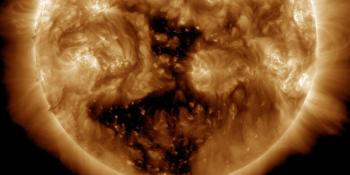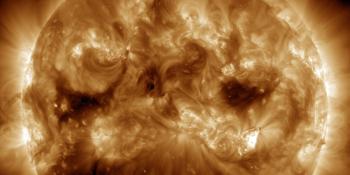Viewing archive of Monday, 16 January 2012
Solar activity report
Any mentioned solar flare in this report has a scaling factor applied by the Space Weather Prediction Center (SWPC). Because of the SWPC scaling factor, solar flares are reported as 42% smaller than for the science quality data. The scaling factor has been removed from our archived solar flare data to reflect the true physical units.
Report of Solar-Geophysical Activity 2012 Jan 16 2200 UTCPrepared by the NOAA © SWPC and processed by SpaceWeatherLive.com
Joint USAF/NOAA Report of Solar and Geophysical Activity
SDF Number 016 Issued at 2200Z on 16 Jan 2012IA. Analysis of Solar Active Regions and Activity from 15-2100Z to 16-2100Z
Solar activity was at low levels. Region 1402 (N28E53)
produced a long duration event (LDE) early on 16 January. The LDE
began at 16/0236Z, reached a maximum at 16/0444Z and ended at
16/0646Z. A partial-halo CME was seen lifting off the ENE limb,
first observed in LASCO C2 imagery at 16/0342Z with an initial
radial velocity of about 793 km/s. Model output indicated the
potential for a glancing blow from the CME beginning late on 19
January. Other activity included a C5/Sf flare from Region 1401
(N17E51) at 16/1038Z. Both Region 1401 and 1402 doubled in area as
they continued to rotate onto the visible disk. New Region 1404
(N12W29) emerged on the disk as a D-type group, while new Region
1405 (N13E65) rotated onto the disk as an H-type group.
IB. Solar Activity Forecast
Solar activity is expected to be at
low levels with a chance for M-class activity for the next three
days (17 - 19 January), particularly from the east limb complex of
spots.
IIA. Geophysical Activity Summary 15-2100Z to 16-2100Z
The geomagnetic field was at predominately quiet to unsettled levels
with isolated intervals of active to minor storm conditions at high
latitudes. Solar wind velocities, as measured at the ACE
spacecraft, ranged between 350 - 400 km/s through 16/0900Z. At that
point, a gradual increase in wind speeds to about 500 km/s was
observed with a corresponding southward dip to near -10 nT in the Bz
component of the interplanetary magnetic field.
IIB. Geophysical Activity Forecast
The geomagnetic field is
expected to be at mostly quiet to unsettled levels, with isolated
active periods, on day one (17 January). Day two (18 January)
should see a return to mostly quiet levels. By day three (19
January), the field is expected to be at mostly quiet levels through
a majority of the day. Late on 19 January, an increase to quiet to
unsettled levels, with isolated active periods, are expected due to
anticipated effects from a glancing blow from the 16 January CME.
III. Event Probabilities 17 Jan to 19 Jan
| Class M | 25% | 25% | 25% |
| Class X | 01% | 01% | 01% |
| Proton | 01% | 01% | 01% |
| PCAF | green | ||
IV. Penticton 10.7 cm Flux
Observed 16 Jan 140 Predicted 17 Jan-19 Jan 145/150/155 90 Day Mean 16 Jan 144
V. Geomagnetic A Indices
Observed Afr/Ap 15 Jan 004/002 Estimated Afr/Ap 16 Jan 008/008 Predicted Afr/Ap 17 Jan-19 Jan 008/008-005/005-006/006
VI. Geomagnetic Activity Probabilities 17 Jan to 19 Jan
| A. Middle Latitudes | |||
|---|---|---|---|
| Active | 15% | 05% | 10% |
| Minor storm | 05% | 01% | 01% |
| Major-severe storm | 01% | 01% | 01% |
| B. High Latitudes | |||
|---|---|---|---|
| Active | 20% | 10% | 15% |
| Minor storm | 10% | 01% | 05% |
| Major-severe storm | 05% | 01% | 01% |
All times in UTC
Current data suggests there is a slight possibility for aurora to appear at the following high latitude regions in the near future
Oulu, Rovaniemi, Sodankylä, UtsjokiReykjavik
Kirkenes, Tromsø, Trondheim
Murmansk, Vorkuta
Kiruna, Luleå
Latest news
Latest forum messages
Large Coronal Hole 25 168AR4043 21Incoming & Unnumbered Active Regions 1647Aurora photography hints for those of us with smartphones 45Photographing auroras 36
More topicsSupport SpaceWeatherLive.com!
A lot of people come to SpaceWeatherLive to follow the Sun's activity or if there is aurora to be seen, but with more traffic comes higher server costs. Consider a donation if you enjoy SpaceWeatherLive so we can keep the website online!

Latest alerts
16:15 UTC - Geomagnetic activity
Minor G1 geomagnetic storm (Kp5) Threshold Reached: 16:05 UTC
15:15 UTC - Geomagnetic activity
Minor G1 geomagnetic storm (Kp5) Threshold Reached: 14:59 UTC
09:15 UTC - Geomagnetic activity
Minor G1 geomagnetic storm (Kp5) Threshold Reached: 08:59 UTC
06:27 UTC - Hemispheric Power Index
The OVATION model predicts the Hemispheric Power Index to reach 54GW at 07:01 UTC
06:00 UTC - Geomagnetic activity
Minor G1 geomagnetic storm (Kp5) Threshold Reached: 05:51 UTC
Space weather facts
| Last X-flare | 2025/02/23 | X2.0 |
| Last M-flare | 2025/03/27 | M2.0 |
| Last geomagnetic storm | 2025/03/26 | Kp6+ (G2) |
| Spotless days | |
|---|---|
| Last spotless day | 2022/06/08 |
| Monthly mean Sunspot Number | |
|---|---|
| February 2025 | 154.6 +17.6 |
| March 2025 | 132.3 -22.3 |
| Last 30 days | 131.2 -21.8 |





